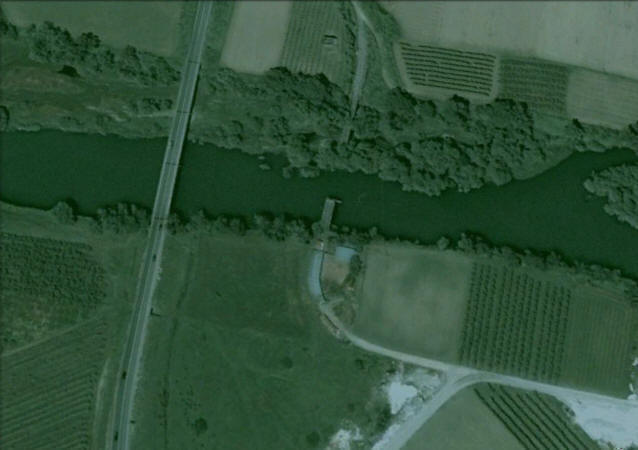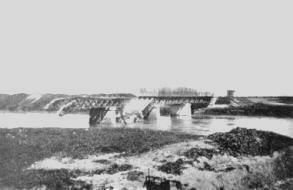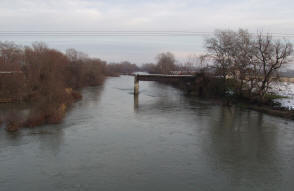
Greece 1941
Aliakmon River
The road bridge
April 12-13
This is Part 1
Part 2


Remains of the road bridge over the Aliakmon River in northern Greece, downstream from today's modern bridge. This is where Divisional Cavalry troops from A Squadron, dug in on the south bank of the river, engaged German forces on the Easter weekend in 1941. They were supported by a 25-pounder gun of E Troop 5 Field Regiment, New Zealand Divisional Artillery, situated on a hill three miles to the south. Google Earth image from 2006.
Operation Marita,
the German
plan to invade Greece, commenced
6 April 1941. The German XVIII
Mountain Corps under General
Böhme crossed into Greece from
Yugoslavia and took Salonika on
9 April. The 2nd Panzer
Division
then headed west to cross the
Aliakmon River and force the
passes to the key towns of Elasson
and Larisa, hoping to encircle
and capture New Zealand and
Australian forces.
The New Zealand Divisional
Cavalry was deployed to patrol
the line along the Aliakmon River
and to fight delaying actions at
key crossings, which would be
destroyed in advance.
DivCav A Squadron, under
Major
John Forsyth Potter, a school
teacher from Hamilton, patrolled
the river north of Aiyinion (known
as
Aginio today) near the coast,
including a key road bridge across
the Aliakmon, just south of Yidha
(Alexandria) and a rail crossing
six miles to the east.
Armoured cars of B Squadron,
under Major John Tinsley
Russell, son of Sir Andrew
Russell (who commanded the
New Zealand Mounted Rifles
Brigade in World War 1) patrolled
the river further upstream to the
west. C Squadron was in reserve
at the DivCav regimental
headquarters near Paliambela.
In support of the DivCav was
E Troop 5 Field Regiment, New
Zealand Divisional Artillery,
under
the command of the
brilliant
gunner, Captain
Thomas Bevan.
He positioned
three 25-pounder
guns on a hill
near Aiyinion
overlooking the
rail bridge, and one 25-pounder
gun on the same
ridge, two
miles to the north,
overlooking
the road bridge over
the Aliakmon.
This gun could also traverse to
cover
the
rail bridge.
2:00 pm, 12 April
Early afternoon on the day before Easter, New Zealand observers noted the sun glinting on vehicle windscreens, ten miles north of the river. This was the 2 Panzer Division convoy. Late in the afternoon, a detachment led by motorcycle scouts in side cars with a handful of troop transports separated from the convoy and approached the road bridge from Yidha.
A Squadron were dug in on the south bank of the Aliakmon (actually a raised floodbank) flanking both sides of the bridge. They held their fire. Bevan on the hilltop and his artillery forward observers also watched the enemy approach. Nobody moved. As motorcyclists approached the bridge proper, the DivCav troop on the right side of the bridge suddenly opened fire with rifles, Bren guns, and anti-tank rifles and were immediately joined by the rest of A Squadron. The engagement was short, 'murderous', and effective. Only one motorcycle was spared and the enemy quickly withdrew. German snipers returned sporadic fire over the remainder of the day.
At 7:15 p.m., as dusk approached, Bevan fired one 25-pounder round for range (from a distance of three miles) adding 1,000 yards to the DivCav's position. He then corrected for line and fired a second round, which according to DivCav troopers fell among German vehicles on the road. These were the first two rounds fired by the New Zealand Divisional Artillery in World War 2.
Overnight, the DivCav and the gunners remained alert. The German troops were reinforced and planned their assault for Easter Sunday.
This is Part One. Look for Part Two soon

A SQUADRON DIVISIONAL CAVALRY
N
↑
ADVANCE GUARD 2 PANZER DIVISION

.jpg)